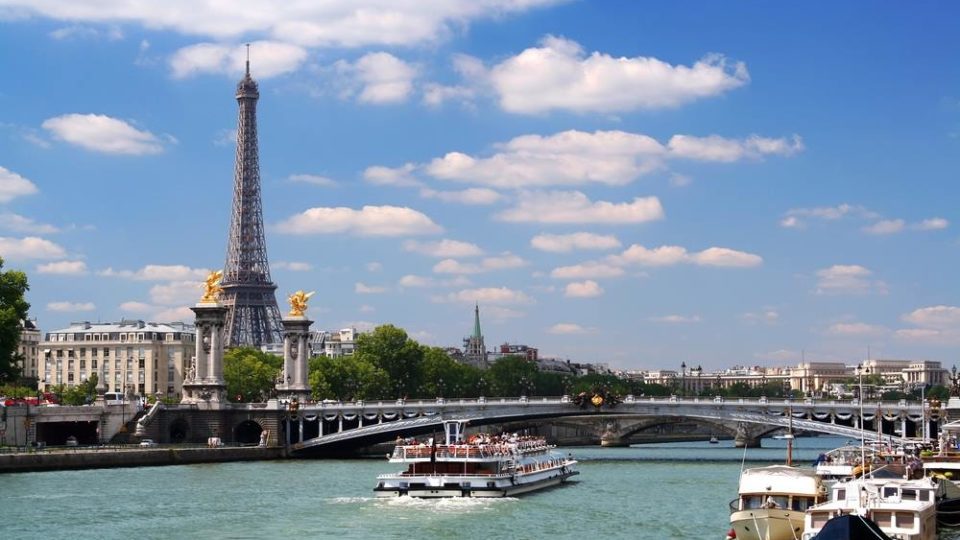Most Beautiful Bridges In Paris
In this article, we will continue our stroll through Paris. This time, we will follow the Seine River as it winds its way through the capital city over almost 9 miles, and point out some of the 33 bridges that cross it, and contribute much charm to the City of Light.
The Seine River and Its Bridges
The Seine has always played an essential role in the development of Paris. The first inhabitants chose to settle on the “Ile de la Cite” (or City Island), because the Seine, which was back then twice as wide as it is today, provided a very efficient natural barrier against barbarian invasions. Through the centuries, fishermen, swimmers, and washerwomen have shared this more or less pure soft water that was an essential part of their everyday lives. It was by boat that Parisians got their wine, wheat, sea salt, wood, and hay. On the coat of arms of the City of Paris, a vessel with a silver sail symbolically represents the important role that river trade played in the development and prosperity of Paris.
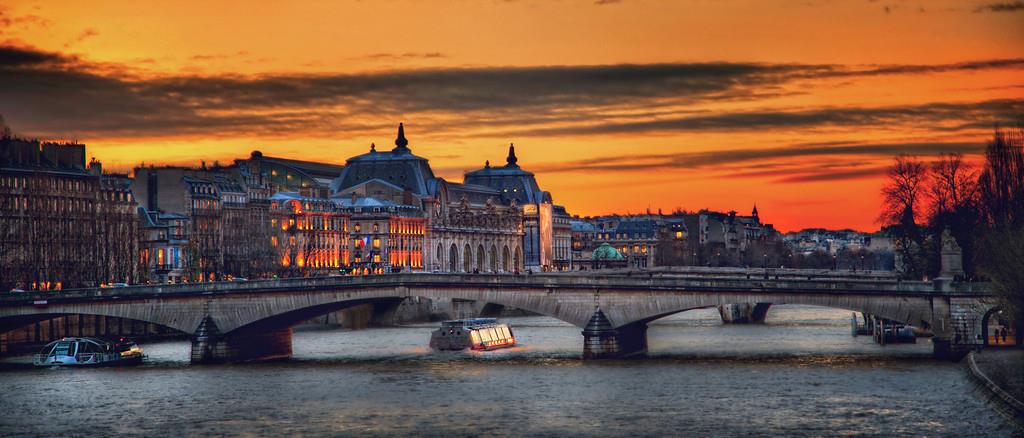
Today, the Seine river splits Paris into two very distinct areas: the Right Bank to the north and the Left Bank to the south. Each is comprised of a mosaic of neighborhoods, very different from one another, yet each special in its own right. Distances are calculated from the Seine outwards; this is reflected in the numeric addresses of apartment buildings that start counting out from the river, and increase as they become more distant from it.
Here Are The Most Beautiful and Famous Bridges in Paris
For centuries, bridges were not only a means of crossing a river. They also served as plants that supplied the hydraulic power necessary for the operation of the watermills and various other mechanisms. However, for over 1,000 years, Paris only had 4 bridges! They were so flimsy that they were regularly swept away by seasonal floods, or they simply collapsed due to the weight of the houses built upon them.
The Oldest Bridge in Paris: The “Pont Neuf”, King of the Parisian Bridges
It was originally named the Bridge of Tears because legend had it that when Henry III came to set the first stone on the 31st of May 1578, he was crying. Apparently, the previous night, two of his beloved courtiers had killed each other in a duel. The king died before the end of the bridge’s construction, and it was Henry IV who ordered the bridge finished in 1598. During its many years of construction, the bridge was nothing but one enormous wooden scaffold made of intertwining planks, where it was very risky to venture.
It quickly became a hideout for bandits, who would rob passerby before throwing them into the water. The bridge was finally finished in 1607 thanks to financial help from Burgundy, Champagne, Normandy and Picardy. These distinct regions that weren’t yet known as France definitely had a vested interest in facilitating the passage of merchant ships. It was in fact the first bridge to be entirely designed for traffic, and on which construction of housing was forbidden. From the Fronde (1648-53, a series of revolts against the king’s growing authority) to the Revolution, the “Pont Neuf”, or New Bridge, was the daily scene of Parisian brawls and violence. For centuries, this place of ill repute served as a shared meeting place for thieves, prostitutes, and con men.
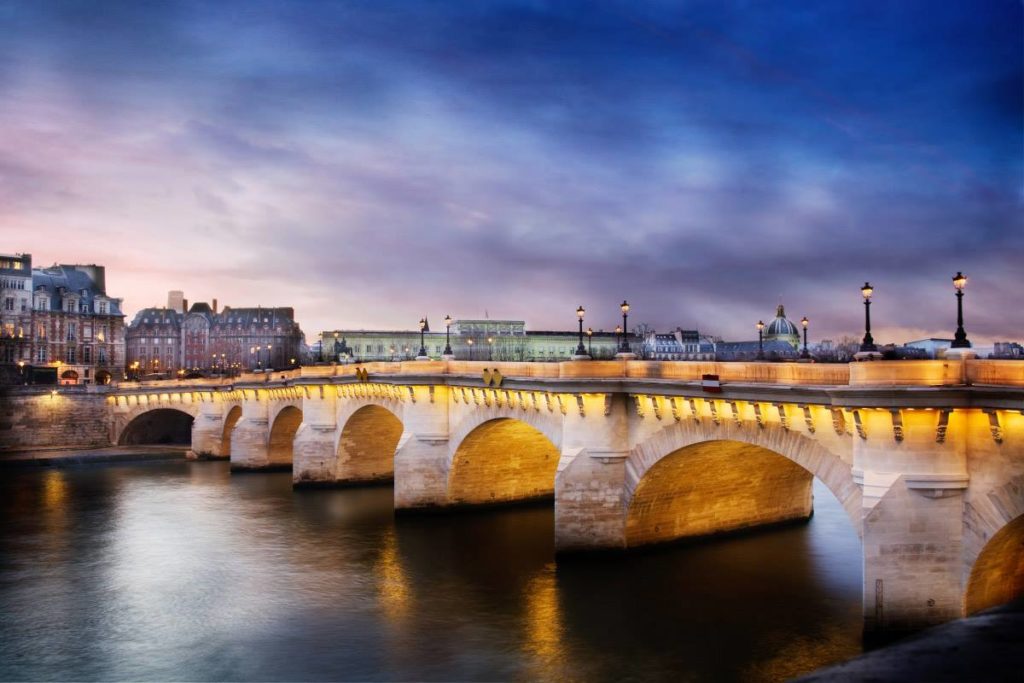
Even the original statue of Henry IV was toppled in 1792, during the French Revolution, and melted to make canons. The statue that stands there today was actually inaugurated in 1817 by Louis XVIII. At the end of the Pont Neuf on the Right Bank, you will find La Samaritaine, the famous department store. It owes its name to the water pump that used to be at the bridge level and supplied water to the Louvre and Tuileries palaces; which included a sculpture of the Samaritan pouring Christ a drink of water. You must visit the rooftop restaurant, which offers one of the most beautiful views of Paris and its bridges.
The Alma Bridge
Napoleon III commissioned the construction of this bridge in 1854 to celebrate the victory of France and England over Russia in Crimea. Originally built entirely of stone, this bridge was part of the “Grands Travaux”, or Great Works as they were known, that Baron Hausmann undertook to link the new neighborhoods on both banks of the river Seine. Because it was so narrow, it was eventually demolished and rebuilt of metal between 1970 and 1974.
It is famous for its statue of a Zouave, the only remaining one from the original four that all represented infantrymen from the Crimean war. It has become the unofficial means of measuring the rise in the water level of the Seine. The Zouaves gaiters are often underwater, and occasionally his pants are too! But in 1910, it was no laughable matter when the water reached his head. Indeed, a tremendous flood had transformed Paris into a city on the water. Such an event could no longer happen today due to flood control brought by modern urban development upstream. Very near this bridge, on Place de l’Alma, one can admire the Flame of Liberty, an exact reproduction of the Statue of Liberty’s flame in New York City.
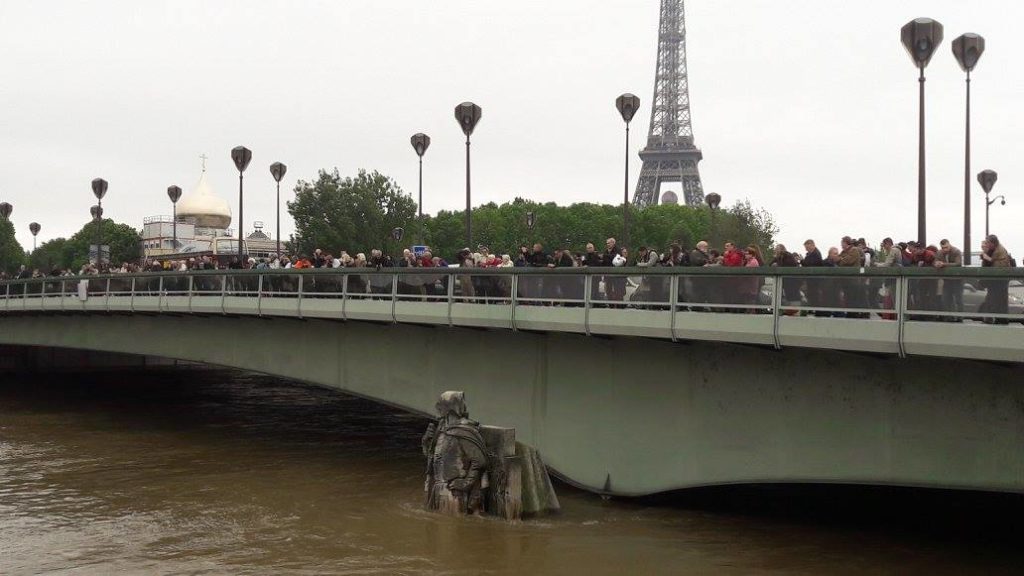
This flame sculpture was a 1987 gift from the International Herald Tribune, to celebrate the centennial of the original statue and reaffirm Franco-American friendship. It has also become a makeshift memorial where, still today, passersby come to place bouquets of flowers for Princess Diana, who died in the Alma tunnel after a terrible car accident in August 1997.
The Alexander III Bridge
Built for the 1900 World Fair, its first stone was laid in October 1896 in the presence of Nicholas II, Tsar of Russia. It is probably the most beautiful bridge in Paris, and certainly the most elaborately decorated. Gigantic candelabras are surrounded by cupids, sea monsters, cherubs, lions, and winged horses at either end. Upstream, hammered brass belles represent the Nymphs of the Seine with the Paris coat of arms, while downstream, the Nymphs of the Neva carry the Russian coat of arms. This classified historical monument is truly a masterpiece of the decorative art and exuberant architecture of the 3rd Republic.
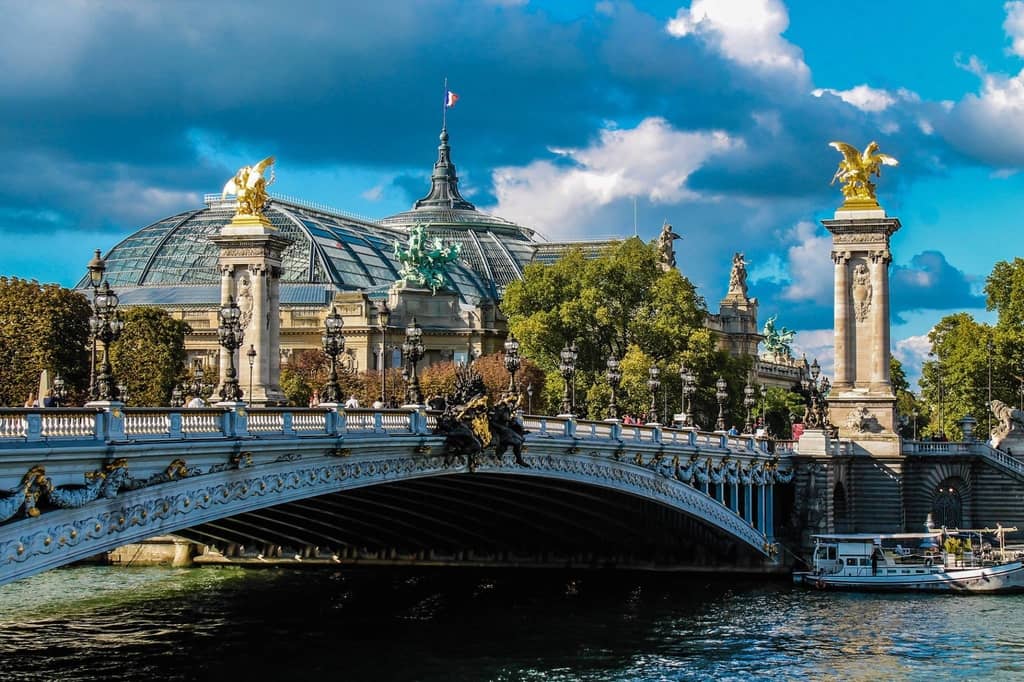
It was, in fact, the first prefabricated structure. Its individual components were forged in factories, then transported by barges and put into place with an enormous crane that covered the entire width of the Seine. Made of one single arch that spans the river, it remains a technical marvel. It has been substantially lowered so as not to obstruct the view of the magnificent Champs-Elysees on the one side and Les Invalides on the other. The Alexander III bridge is a wonderful achievement that never ceases to delight the passerby and the aesthete alike.
The Grenelle Bridge
The Grenelle Bridge is situated all the way downstream, very close to the national public radio building. When it was built in 1827, it was a toll bridge constructed of wood that very quickly showed signs of structural weakness. Despite several repairs, it collapsed in 1873 after an increase in traffic due to festivities in honor of the visit of the Shah of Persia. It was therefore decided that this bridge should be rebuilt entirely of cast iron in 1874. What makes this bridge unusual is that it is symmetrically divided by a long sliver of land in the middle of the Seine, called “Swan Alley”, accessible by a footbridge.

At the point of this little island is a circle that was designed to showcase a bronze statue, the exact quarter-size replica of the Statue of Liberty of New York. This one was a gift from the US to France in commemoration of the centennial of the French Revolution and was inaugurated on the 15th of November, 1889. Originally, it faced upstream towards the Eiffel Tower (so as not to turn its back on the Elysee Palace), much to the chagrin of its creator, Bartholdi, who was disappointed that it did not face the New York City Statue of Liberty. He finally got his wish when it was rotated to face America for the World Fair of 1937.
The First Bridges: The Small Bridge and the Big Bridge (Ile de la Cite)
When Paris was still called Lutetia, there were two wooden bridges built in the same extended axis; one beyond the other. These bridges were true fortresses, closed off by gates and towers. Even the Vikings, in the 9th century, we’re unable to break through despite a naval armada of 700 ships. Only when a flash flood in 866 took out the Big Bridge, were the Vikings able to invade the city. Throughout the centuries, these two bridges were continuously destroyed by floods and tirelessly rebuilt. Unfortunately, without ever taking into consideration the laws of physics, namely the weight of the houses they had to support.
However, these design flaws didn’t keep the bridges from playing an important role in the pomp and splendor of the Middle-Ages. The large “rue Saint-Denis” was the route taken by kings when entering the capital city before taking the Big Bridge. It was also used for other official processions, such as those that occurred during weddings between nobles, victorious returns from wars, or visits from foreign dignitaries. The expression “monkey money” (worthless money) comes from the history of Paris’ “Small Bridge”, which was originally a toll bridge. Only street performers were allowed to cross it free of charge, and only if they were able to get their performing monkeys to make funny faces!
Many Bridges During Your Stroll Along the Banks
A visit to Paris would not be complete without a stroll along the banks of the Seine. What a pleasure it is to take a leisurely walk along the embankment, to leaf through old books at the stalls of secondhand booksellers, to admire the works in progress of artists who have come to capture the light at dusk, all the while enjoying the spectacle of Paris’ monuments and bridges. Another original and fun way to visit this open-air museum is to hop on a “bateau-mouche” near the Alma Bridge. You can go aboard various other sightseeing boats from near the Pont Neuf or the Iena Bridge, near the cathedral of Notre-Dame or near the Eiffel Tower.
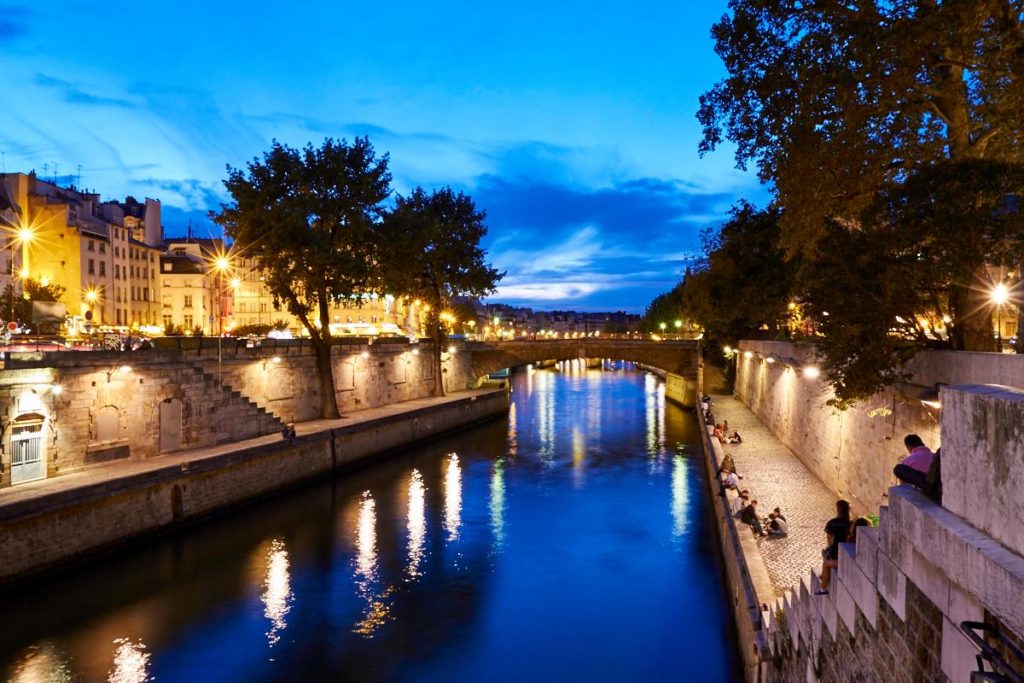
Pont des Arts
Linking the Palais du Louvre to the esteemed Institut de France, this bridge is a pedestrian-only bridge that is cherished by both locals and tourists. Visitors and Parisians visit in their drove in the summer and spring months for splendid picnics looking over the Seine River. Instagram-worthy shots from Pont des Arts are simply striking. You can have to treat yourself to amazing views overlooking the Louvre, the Eiffel Tower, and the shining play of light on the river.
Pont des Arts used to be a place where couples place their ‘lovelocks’ (as you might have seen in movies and Instagram), but it has been removed for safety reasons. Nevertheless, this incredible metal bridge, first constructed in 1802 by Emperor Napoleon and rebuilt in the 1970s, is a must-visit, especially for holidaymakers coming to Paris for the first time.
Today, the bridge looks modern and just as stunning, with the Institut de France perched on the left and the Louvre framing structure at its right bank side. The simplest way to reach Pont des Arts is to get off at the Louvre-Rivoli metro station or Pont Neuf and proceed west along the Seine.

Pont Marie
This adorable but less popular bridge is a perfect spot between the Ile de la Cité (an island on the Seine River) and the Marias area on the right bank. The present state of the bridge dates back to around 1670, after a fire incidence on its former wooden form which was engulfed in the fire. Its five stately arches are gothic because the supports have not been embellished with statues.
From Pont Marie, you can get magnificent views over other bridges westward and the Seine River. Discover chateaus, quays of the Ile de la Cité and winding streets, or stroll through the Renaissance and medieval sites of the Marias.
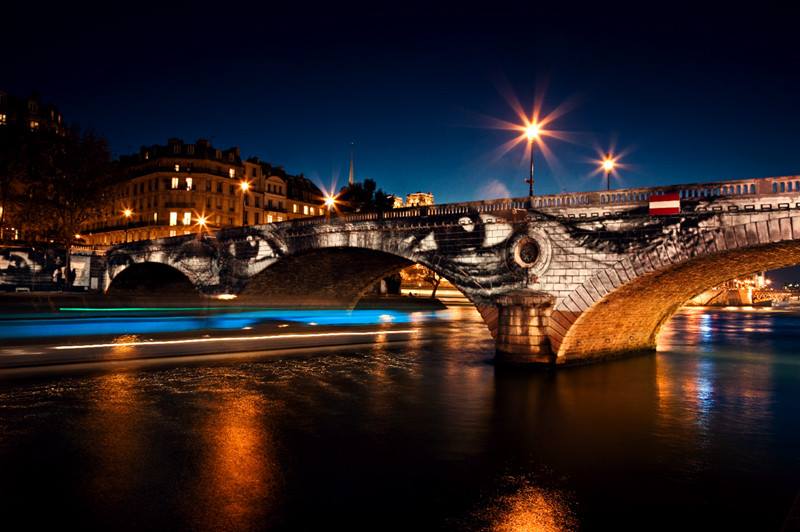
Pont Double
For spectacular views of the Notre-Dame Cathedral, this bridge is matchless. Pont Double is a metallic bridge with a single arch that was constructed in the 1800s. It links the Quai de Montebello on the left bank and the Parvis du Dame outside the popular Cathedral. From Pont Double, vistas over the Latin Quarter and Ile de la Cite are simply breathtaking.
When you visit, you can hop on any of the numerous boat tours of the Seine from the Quai de Montebello or step into the nearby Shakespeare and Company bookshop. Getting to the Pont Double is not difficult. The easiest way is to reach the Metro Saint-Michel and proceed to the Quai St-Michel east. This leads to the Quai de Montebello, and you can follow it until you reach Pont Double on the left.
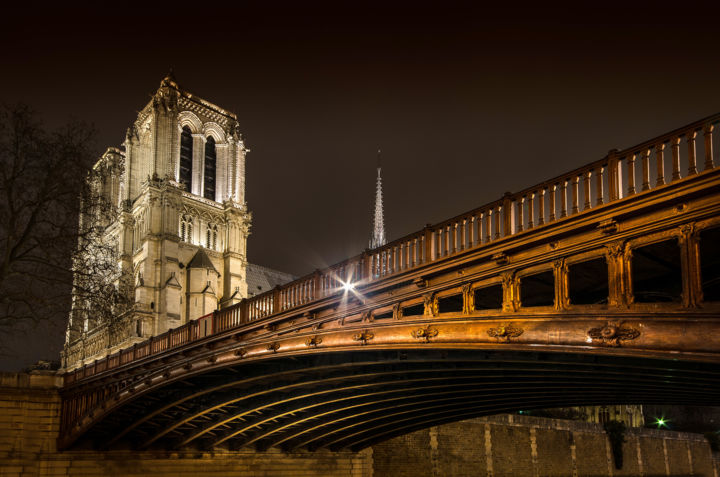
Pont de la Concorde
Pont de la Concorde is an esteemed bridge that links the Palais Bourbon on the left bank of the Seine to the significant Place de la Concorde. It was constructed in 1791 in the course of the Revolution. In the 1900s, the bridge was massively broadened to accommodate vehicle traffic.
From Pont de la Concorde, visitors can enjoy great views over the Tuileries Gardens, the Musee and Palais du Louvre, and the large Egyptian obelisk on the Place de la Concorde. To get there, descend at the Concorde Metro station and follow signs that lead to Pont de la Concorde. Walk east to the bridge if you are coming from the left bank and stop at the RER/Invalides Metro station.

The Bridges of the Canal St-Martin
Lots of tourists do not visit this bridge- but they should set foot on it. It used to be an industrial waterway. Today, it is the hub of a lively and genuine local area graced by Parisians, especially in the evenings and summer months. This place also holds some fine footbridges that are arched.
These incredible green metal structures are lovely to see, regardless of the days’ time you have visited. You can stand at the summit of one to behold the canal and its beautiful banks. When you are there, do as locals do and spare a moment to visit a chic café, old hotel bar or wine bar.
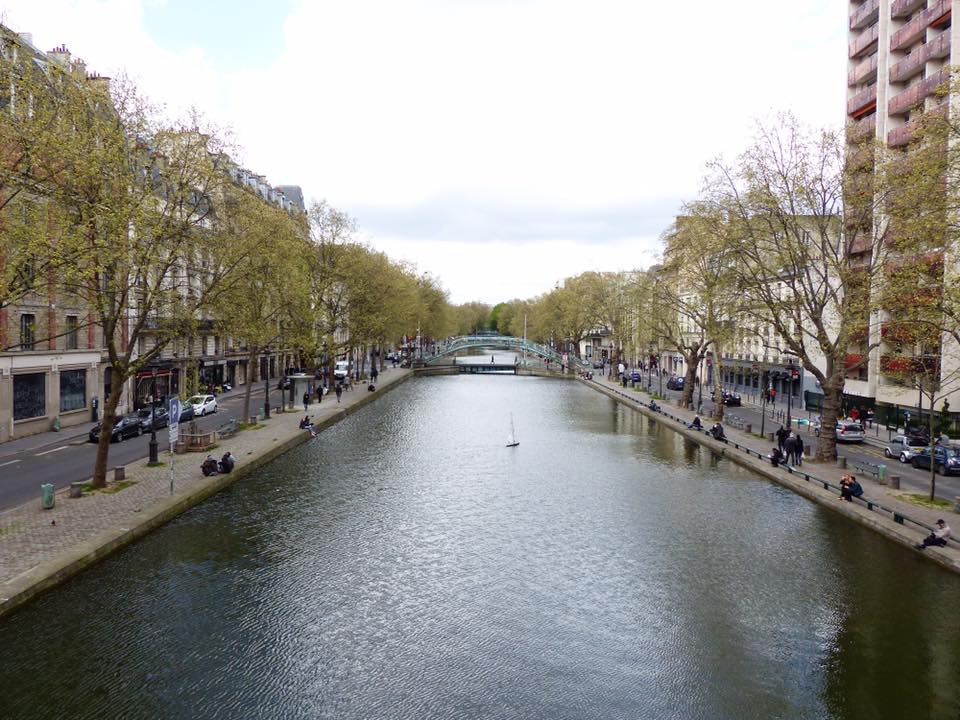
Pont de la Tournelle
The present three-arched bridge that elegantly links the Ile de la Cite to the left bank on the Quai Saint-Bernard is among the ones that have been here for centuries. From the 1500s, a wooden bridge was on the site, but it was worn away by ice. The bridge that you will see when you visit has stood since 1928. Pont de la Tournelle is made up of two smaller arches on each side and a massive in the center. From there, you can take on the eastern section of the Latin Quarter, which is attractive.

Most Beautiful Bridges In Paris – Summary
The city of Paris has all the interesting architectural designs you would come to appreciate. Paris is marked with the two sides of the great Seine River on both banks. However, you can stay on a side because there is much to do and see. The bridges will help visitors and locals enjoy the specialties on either side of the river much to their satisfaction. These bridges are both destinations on their own and a means to get to where you are going.
